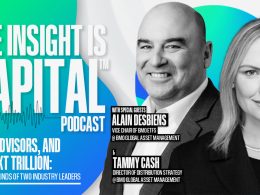Rise of the machines: Winners and losers in the robo-advisors battle
by Wesley Gray, Alpha Architect, via CFA Institute
We love a good fight. There was Rocky versus Drago and Optimus Prime versus Megatron, and now we have the ultimate conflict in the tumultuous world of financial services: robo-advisers versus traditional registered investment advisers (RIAs).
The battle is well under way and the gloves have come off. This summer, Wealthfront CEO Adam Nash launched an all-out barrage on Schwab and Betterment. Another firm, WiseBanyan, announced plans to debut a “free” robo-adviser, while the Vanguard juggernaut launched a human-hybrid robo (do they call it a cyborg adviser?). In short order, Vanguard has emerged as the dominant force in the robo-advisory market.
Everyone — including my firm — seems to be launching a robo-adviser these days. At every conference we attend and every panel we speak at, with every influencer we talk to, the same thing seems to be on everyone’s mind:
How Is This “Robo Thing” Going to Play Out?
Below are our predictions for the future of robo-advising. We identify a couple losers and winners based on the current trends we see in the market. For clarity’s sake, we define a “robo-adviser” as an adviser that exclusively leverages software to service a client, whereas a traditional RIA setup involves a human being delivering guidance to a client.
Big Loser: Slothosaurus RIAs
Traditional RIAs are worth their weight in gold for one simple reason: They save us from ourselves. RIAs are the much-needed psychology coach who keeps us from jumping off the cliff when the market tanks. They also prevent us from doubling down and mortgaging our third home at a market peak. In short, good RIAs help us minimize our own behavioral biases.
Good RIAs that provide these solid benefits should be safe. Clients will gripe about fees, but human-to-human interaction will maintain its value to the extent that robo-advisers cannot replicate it. So chalk one up for the traditional advisers.
But simply being a human being is not going to be enough. Traditional RIAs should still be terrified of robo-advisers and must embrace technology. One particular species of RIA should be especially worried: the Slothosaurus.
Slothosaurus is a unique RIA phenomenon. A child of the good old days — 5% commissions, 2% management fees, hatred of all things tech — Slothosaurus accumulated assets in an earlier time, an era of less competition, more ignorance, and fatter margins. Slothosaurus considers its edge to be “great relationships.” Slothosaurus often loves great relationships for the wrong reasons: The goal of the relationship is not to maximize client value, but to create “stickiness.” Sadly, Slothosaurus faces a problem when clients pass wealth onto their heirs — the kids don’t value “relationships” and they hate being stuck in a win-lose situation. They bolt for a lower cost, more transparent, more proactive RIA that actually has a value proposition beyond “paid friend.” Robo-advisers will accelerate the demise of this species. Slothosaurus RIAs that are not evolving, innovating, or embracing technology to enhance client value, will quickly go extinct.
Potential Loser: Undifferentiated Robo-Advisers
Passive portfolios are a commodity product — any investor can buy a basket of low-cost, tax-efficient index exchange-traded funds( ETFs) through their personal brokerage account. Moreover, how one puts these products together is somewhat irrelevant: In expectation, there is little difference between one fancy asset allocation model and another. In fact, asset allocation models that equally weight assets typically meet or beat the performance of complex approaches.
So where does that leave the current group of robo-advisers?
Unfortunately, the typical offering is a commodity: a passive portfolio that follows a generic allocation algorithm (e.g., mean variance analysis). And to make matters worse, the newest robo-advisers aren’t making the underlying commodity (i.e., the underlying funds). In many respects, generic robo-advisers are just adding a layer of expenses on top of underlying commodity products. Typically, the winner in this sort of market goes to the producer with extreme operational efficiency and economies of scale. In other words, firms like Vanguard, which manufacture the underlying products and have scale, or like Charles Schwab, which manufacture products, generate distribution fees, and have scale. These firms are the natural winners in this race, not the current crop of robo-advisers.
Playing the tape forward, generic robo-adviser services will be free, and the economics will be associated with the underlying investment products and distribution fees, not the robo-advisory service. We see this race to the bottom in realtime: Wealthfront is lowering their minimums/costs, WiseBanyan dropped their fee altogether, and Schwab’s Intelligent Portfolios service is free. Of those three players, only one can make money when the robo-advisory service is free — Schwab!
The robo-adviser movement is here to stay, but without a differentiated product offering or a unique business model, running a profitable, plain-vanilla passive allocation robo-adviser will be challenging.
Potential Winners: Differentiated Robo-Advisers
A big problem with financial services is the distribution challenge: How do you get your product to market? The typical approach involves leveraging a bank’s foot soldiers or partnering with a broker in a pay-to-play arrangement. The distribution challenge creates a problem: Good ideas and strategies are unable to get to market because the intermediary channel can’t maximize profits. A potential solution: disintermediate financial services! Fortunately, improved investor education, cloud-based adviser technologies, and smart social media marketing efforts are facilitating the disintermediation revolution.
That’s why we love the robo-adviser concept. Any asset manager, adviser, or innovator can take their idea, leverage technology, and provide a comprehensive direct-to-consumer solution, cutting out the middle man along the way. Moreover, even if you don’t have millions in marketing dollars, your product has an opportunity to sell itself — drumroll please — on merit. So, for those advisers who believe they have a robust process, a quality team, and a value-add service, the robo channel enables them to bypass many traditional — and often expensive — distribution channels and go direct to the consumer. The key, of course, is to have a well-defined value proposition, a differentiated product, and a clear market segment.
Big Winners: Consumers of Financial Services
To be clear, we love the robo-adviser movement. Anything that helps individuals access affordable financial advice is a welcome innovation.
The ability to service small accounts with (somewhat) tailored advice is revolutionary. From an adviser-profitability perspective, the investment management process is labor intensive. Advisers must consult with the client, establish asset allocations, monitor expenses, rebalance periodically, manage taxes, and communicate with the client on an ongoing basis. You can make a good case that the same amount of work goes into managing a portfolio, regardless of its size. For example, consider the case of John Doe, a financial adviser who is providing investment management services. Let’s say John is sitting in his office one day, and he gets two emails. The first email is from Bill Baby Boomer, who has $1,000,000 to manage, and the second email is from Mark Millennial, who has $10,000 he wants managed. John would like to help both prospective clients, but he has to assess both of these opportunities.
Bill is pretty easy. John can charge Bill 1.00% on the $1,000,000, which means John will earn $10,000 in fees every year. This compensates him for the time he would spend managing Bill’s portfolio. The situation with Mark is more problematic. If John charges a 1.00% fee on Mark’s portfolio, he will only earn $100. John cannot justify opening an account for Mark because he can’t cover the fixed costs of his time. For John to justify an advisory relationship with Mark, he would need to charge him upwards of 5% or perhaps 10% of assets, which would equate to $500 to $1,000 in annual fees, or one tenth the fees generated by Bill’s account. In effect, Mark’s lack of assets shuts him out of the financial advice market.
With robo-advisers, Mark is back in the game. Asset allocation, tax efficiency, and other high-net-worth “classics” can now be provided to all consumers. And, as mentioned above, the all-out slugfest occurring between the big names on price and service is a win for customers. Robo-advisers are creating a lot of value, and it is the customer, not the adviser, who is capturing the lion’s share of it. Unfortunately, businesses that add value, but are not able to capture it, tend to have short lifespans (See the Slothosaurus).
The Machines Are Here to Stay: Adapt or Die
Robos are changing the landscape of financial services and consumers will reap the rewards. But will the computers replace humans? Unlikely. The psychology coach benefit is hard to replicate with a computer. However, robos will encourage human-based advisers to up their games. Slothosaurus will go extinct—thankfully! First iteration passive robo-advisers will create a lot of value for consumers but capture little value for their venture capital (VC) investors. Finally, differentiated robo-advisers and traditional advisers who embrace technology will score big wins for both consumers and their shareholders.
If you liked this post, don’t forget to subscribe to the Enterprising Investor.
All posts are the opinion of the author. As such, they should not be construed as investment advice, nor do the opinions expressed necessarily reflect the views of CFA Institute or the author’s employer.
Image credit: ©iStockphoto.com/CSA-Archive














